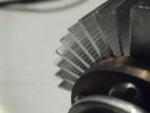Richie89
0
- Joined
- May 9, 2015
- Messages
- 1,181
- Points
- 113
It's funny because I've been trying new ideas because I don't have large heat sinks.
I wanted to fire my laser directly straight up into the clouds and just sit there and admire it's beauty without worrying about rushing to shut it off every 45-60 sec. so I was thinking that if I could figure out how to keep that head/heatsink/module cool or around 45-55 degrees Fahrenheit than I'll triple my D cycle. So I threw a relatively small hand towel in the freezer making sure it was a tad damp and not soaked, let it near Freeze and wrap it around the head with a rubber band. I did this and went outside leaving it on for several minutes maybe 5 minutes and after turning it off I used my IR thermometer and found that the module was only sittin about 15 degrees hotter than usual. I doubt this same thing would work for a laser pushing over 3 amps and an output of over 4 watts, the one I used for this experiment was only a 1.2 watt 445.
Anyways I felt I had to share this with you all.
I wanted to fire my laser directly straight up into the clouds and just sit there and admire it's beauty without worrying about rushing to shut it off every 45-60 sec. so I was thinking that if I could figure out how to keep that head/heatsink/module cool or around 45-55 degrees Fahrenheit than I'll triple my D cycle. So I threw a relatively small hand towel in the freezer making sure it was a tad damp and not soaked, let it near Freeze and wrap it around the head with a rubber band. I did this and went outside leaving it on for several minutes maybe 5 minutes and after turning it off I used my IR thermometer and found that the module was only sittin about 15 degrees hotter than usual. I doubt this same thing would work for a laser pushing over 3 amps and an output of over 4 watts, the one I used for this experiment was only a 1.2 watt 445.
Anyways I felt I had to share this with you all.
Last edited:







